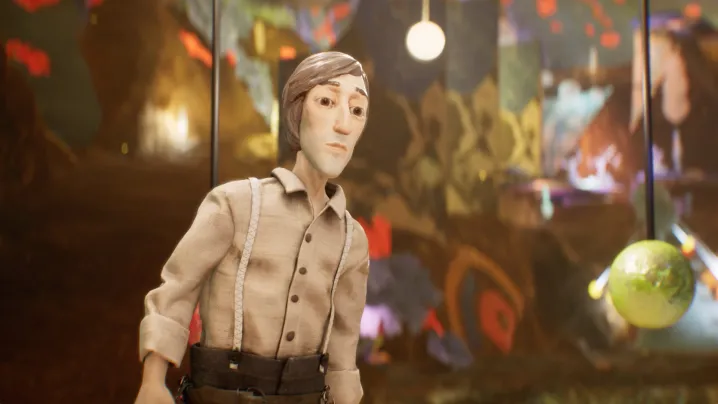“Harold Halibut makes some key compromises to make its eye-popping claymation art style work.”
- Amazing visual style
- Detailed sets
- Inventive writing
- Memorable characters
- Slow pace
- Limited world
- Lacking meaningful interactivity
It’s not the ocean that’ll drown you in Harold Halibut; it’s complacency.
In the ambitious debut from Slow Bros., a small community lives out a lonely life aboard a spaceship that’s trapped underneath an alien planet’s ocean. As the ship’s few scientists work to craft plans to relaunch the ship back into space, its eccentric locals have learned to accept their isolated, water-logged lives. That includes Harold, a janitor who has never seen life beyond the few metal corridors he was raised in. And while the possibility of freedom should give him cause for celebration, it serves as a point of anxiety, too. What if a proper life on land isn’t all it’s cracked up to be? Maybe it would just be easier to drown in comfort.
That human story does a lot of heavy lifting in Harold Halibut, a respectable debut torn between worlds. As a narrative experience, it’s a jaw-dropping feat thanks to strong writing and a unique handmade art style unlike anything I’ve seen in a game before. That cinematic style leads to some sacrifices, though, as slow pacing, a limited world, and a lack of meaningful interaction make it less engaging as a work of interactive fiction. But if Harold Halibut taught me anything, it’s that I’d rather take a daring creative vision like this over a safe, boring one.
Lost in space
Harold Halibut is a narrative-focused adventure game that shares tonal similarities to the animated works of Wes Anderson. Set on the Fedora, a sunken spaceship that’s turned into an isolated town linked by a tube transit system, the 10-hour story is told through dry humor, understated social satire, and banter with local eccentrics. Despite its grim sci-fi setup, it’s a warm and endearing story that treats each resident of the Fedora with empathy, from the ship’s weirdo captain to its lovable old mailman.

In its early chapters, there’s an emphasis on the mundane. I spend the first few hours doing menial labor as Harold, fixing water filters and scrubbing mysterious graffiti off of walls. It’s a maddening but effective introduction to Harold’s claustrophobic world. In its first five hours, I’m slowly walking between a small handful of mini-districts on the ship, all at the mercy of a painfully slow transit system that even a Fedora lifer like Harold is sick of. By the time the story introduces its first twist, as Harold discovers a fishlike alien stuck in the Fedora’s filter, I’m eager to escape.
The plodding, repetitive setup would perhaps work better if there were something fresh to look forward to on the other side of the story. That’s where Harold Halibut hits some of its struggles as a game, something that’s sure to make it an acquired taste. While its third chapter feels like it’s building towards a change of pace when I set out to find my alien pal’s homeland underwater, the grand reveal underwhelms. The second half of the story introduces a second explorable space that feels just as small and restrictive as the Fedora. I struggle to find the moment of escape that winds up being so crucial to Harold’s own world-expanding growth.
The sweet story earns its emotional beats …
Some clever use of interactivity could have helped matters, but Slow Bros.’s decision to deliver the story with as few gameplay distractions as possible further robs Harold Halibut of its epiphany moment. For most of my playthrough, I’m not doing much more than retreading the same few spaces and striking up world-building conversations. More involved gameplay moments are few and far between. I only get a light handful of janitorial puzzles — mundane tasks like unscrewing the cover off of a complicated 3D printer or processing alien rocks. Those little jolts of interactivity wind up being more engaging than anything I do outside of the ship, sapping some power out of its ultimate conclusion.
Though it struggles as a work of interactive fiction, Harold Halibut works on the strength of its sharp writing. The sweet story earns its emotional beats, slowly painting a picture of an isolated man learning to break out of his comfort zone on his own terms. Rather than being carried along by wherever the Fedora and its hare-brained pseudo-scientists take him next, he must learn to walk his own path outside of the rusty prison he was born into.
Handcrafted to perfection
Though Harold Halibut stumbles in its limited interactivity, its stronger selling point is its visual style. Using painstaking photogrammetry, Slow Bros. hand-created every character and object in the game, digitizing each through hundreds of photographs. The result is a visual style that no game has ever fully delivered. It’s almost surreal, like I’m playing a lost European claymation cartoon from the 1980s. It doesn’t feel like I should be able to control it, and yet, I can.
Harold Halibut is filled with economical decisions.
Slow Bros.’s love of stop-motion history shows in its incredibly detailed world. I get shades of Jan Švankmajer and the Brothers Quay as I walk through the weathered halls of the Fedora, a ship shaped by bumpy materials and muted colors. I can almost see the thumbprints under Harold’s tired eyes, a physical touch that brings more humanity to the character models. That’s further helped by its motion-captured animation techniques, giving each member of the oddball cast more expressive body language.
It’s a triumphant feat, though one that seems to create some key trade-offs. The decision to drop players in a small handful of areas feels like a necessity to reduce the need for even more physical sets. The fact that the bulk of the gameplay takes place in shot/reverse shot conversations with NPCs feels like another way to get around that problem. Harold Halibut is filled with economical decisions like that, which come at the expense of surprise.

When I think of great uses of stop-motion animation, it’s the transformative works that stick in my mind. I still feel Street of Crocodiles in my bones thanks to its gritty world that feels born from recycled trash and discarded toys. Švankmajer’s Darkness, Light, Darkness plays with the moldable nature of physical clay to joke about the awkward design of the human body. The handcrafted nature of Harold Halibut does lend it palpable authenticity, but it feels like Slow Bros. only starts to explore the deeper relationship between its medium and message by the end of the adventure.
Though Harold Halibut leaves me with a lot to pick at, it’s a fitting debut for what’s sure to become one of gaming’s most exciting new studios. Like Harold himself, Slow Bros. finds itself pushing gaming’s mundane comfort zone into the stratosphere with an approach that few will dare to replicate. It’s a bold risk; I’m sure the studio could have made a lot of commercially viable games in the 14 years it took to put this together. But why settle for stagnation? It’s more rewarding to try something new, breaching the creative surface rather than sinking underneath the waves. Harold Halibut may be a flawed maiden voyage, but Slow Bros. is destined for the stars.
Harold Halibut was tested on PC.




